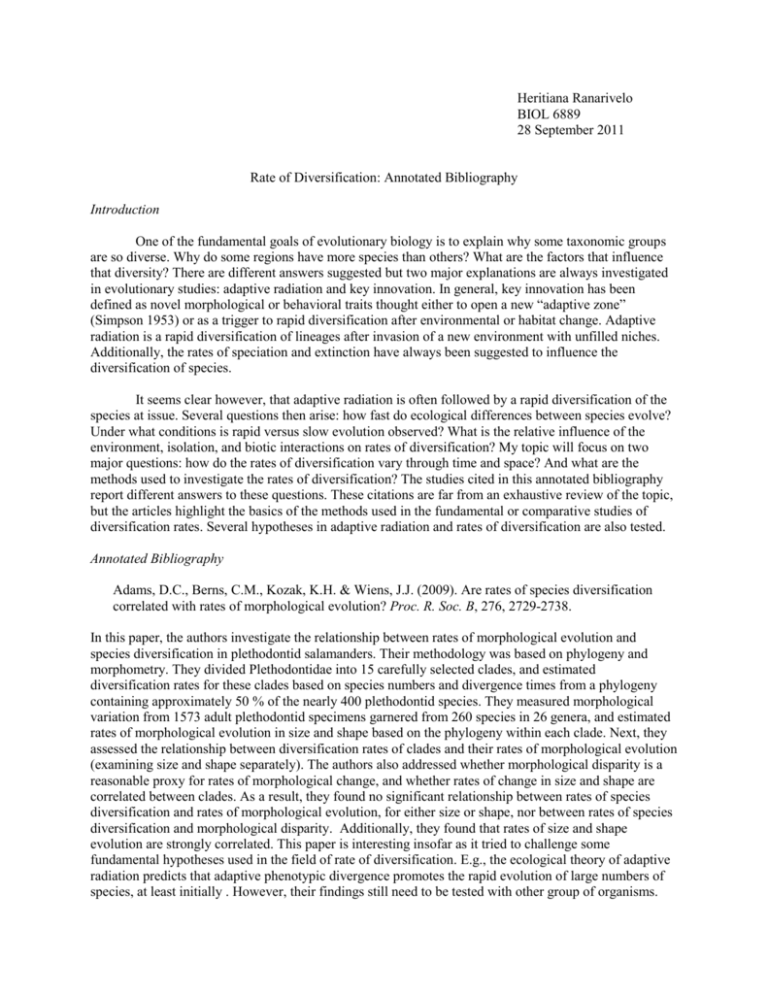Rates of diversification annotated bibliography
advertisement

Heritiana Ranarivelo BIOL 6889 28 September 2011 Rate of Diversification: Annotated Bibliography Introduction One of the fundamental goals of evolutionary biology is to explain why some taxonomic groups are so diverse. Why do some regions have more species than others? What are the factors that influence that diversity? There are different answers suggested but two major explanations are always investigated in evolutionary studies: adaptive radiation and key innovation. In general, key innovation has been defined as novel morphological or behavioral traits thought either to open a new “adaptive zone” (Simpson 1953) or as a trigger to rapid diversification after environmental or habitat change. Adaptive radiation is a rapid diversification of lineages after invasion of a new environment with unfilled niches. Additionally, the rates of speciation and extinction have always been suggested to influence the diversification of species. It seems clear however, that adaptive radiation is often followed by a rapid diversification of the species at issue. Several questions then arise: how fast do ecological differences between species evolve? Under what conditions is rapid versus slow evolution observed? What is the relative influence of the environment, isolation, and biotic interactions on rates of diversification? My topic will focus on two major questions: how do the rates of diversification vary through time and space? And what are the methods used to investigate the rates of diversification? The studies cited in this annotated bibliography report different answers to these questions. These citations are far from an exhaustive review of the topic, but the articles highlight the basics of the methods used in the fundamental or comparative studies of diversification rates. Several hypotheses in adaptive radiation and rates of diversification are also tested. Annotated Bibliography Adams, D.C., Berns, C.M., Kozak, K.H. & Wiens, J.J. (2009). Are rates of species diversification correlated with rates of morphological evolution? Proc. R. Soc. B, 276, 2729-2738. In this paper, the authors investigate the relationship between rates of morphological evolution and species diversification in plethodontid salamanders. Their methodology was based on phylogeny and morphometry. They divided Plethodontidae into 15 carefully selected clades, and estimated diversification rates for these clades based on species numbers and divergence times from a phylogeny containing approximately 50 % of the nearly 400 plethodontid species. They measured morphological variation from 1573 adult plethodontid specimens garnered from 260 species in 26 genera, and estimated rates of morphological evolution in size and shape based on the phylogeny within each clade. Next, they assessed the relationship between diversification rates of clades and their rates of morphological evolution (examining size and shape separately). The authors also addressed whether morphological disparity is a reasonable proxy for rates of morphological change, and whether rates of change in size and shape are correlated between clades. As a result, they found no significant relationship between rates of species diversification and rates of morphological evolution, for either size or shape, nor between rates of species diversification and morphological disparity. Additionally, they found that rates of size and shape evolution are strongly correlated. This paper is interesting insofar as it tried to challenge some fundamental hypotheses used in the field of rate of diversification. E.g., the ecological theory of adaptive radiation predicts that adaptive phenotypic divergence promotes the rapid evolution of large numbers of species, at least initially . However, their findings still need to be tested with other group of organisms. Day, J.J., Cotton, J.A. & Barraclough, T.G. (2008). Tempo and Mode of Diversification of Lake Tanganyika cichlid fishes. PLoS ONE 3(3): e1730. doi:10.1371/journal.pone.0001730. The authors investigated relationships of rate of radiations within and among species, and explored the effect of the interaction between traits and environment to the rate of diversification as well. For this purpose, they chose the cichlid fishes of Lake Tanganyika (LT) and compared diversification rates between the LT and the Lake Malawi (LM) and Lake Victoria (LV) species flocks. They also compared the LT cichlid faunas, estimated the net diversification rate for the endemic tribes, and compared the average speed of diversification among tribes. A phylogenetic approach with dating methods was used. Additionally, they included in their methods the potential effects of missing species on estimates of the timing and rate of diversification. They used models assuming constant per lineage rates of speciation and extinction to estimate average net diversification rates. Their main findings are: LT cichlid fishes have diversified much more slowly than those of LV and LM, even the endemic LT haplochromines. In contrast to LM and LV, the LT species flock derives from a prolonged accumulation of species, rather than rapid, recent radiation. Among the tribes there is no significant decline in rate of radiation over time. They conclude that the environment plays a major role in determining cichlid diversification rates. The authors suggested that similarity of net diversification rates among tribes with very different biological characteristics might imply that traits had minimal influence on the progress of diversification in the lake. The authors made a good attempt to explain the biological explanation underlying their findings, and present a good example of highlighting the changes of rate of diversification between taxa, within taxa, and across different regions. Gavrilets, S. & Vose, A. (2005). Dynamic patterns of adaptive radiation. Proc. Nat. Acad. Sci. USA, 102, 18040-18045. The authors attempted to build simulation models of very large-scale evolutionary diversification. Their approach was simple, though the details of the methods were complicated: the preference for new niches occurs simultaneously with new ecological niches. This preference would be genetically controlled. The authors’ findings are consistent with empirical adaptive radiation theories and they suggest a genetic explanation for those results: (1) the models support the area effect, new locally advantageous genes may become better protected by distance from the diluting effect of locally deleterious genes; (2) increasing the number of loci underlying the traits decreases diversification because a larger number of loci implies weaker selection per each individual locus and a stronger overall effect of recombination in destroying co-adapted gene complexes; (3) the number of species peaks early in the radiation (overshooting) because speciation events occur soon after colonization of a new environment, so the genetic constraints are less strict than later on; (4) the model suggests that local extinction can promote establishment of the species in a new environment; (5) the diversification is most extensive when the phenotypic traits are controlled by few loci, therefore the genetic architecture of traits underlying the adaptive radiations might be simple. The advantages of the models are that they take into account the extinction and genetic parameters, then can perform a simulation on a very large scale. However the methodology is dependent on and limited by the power of the computing and an important ecological factor could be easily neglected by attempting to include too many parameters. This work is a good example of models including genetic information in their simulation of adaptive radiation on a large scale. Harmon, L.J., Melville, J., Larson, A. & Losos, J.B. (2008). The role of geography and ecological opportunity in the diversification of day geckos (Phelsuma). Syst. Biol., 57(4), 562-573. The authors tested two hypotheses: (1) the rates of speciation and morphological evolution increases following colonization of islands unoccupied by competitor species; and (2) speciation rates are positively correlated with island area. They compared the rates of diversification, including both speciation and morphological evolution, for independent radiations of day geckos in four geographic areas: Madagascar, and the Mascarene, Seychelles, and Comoros Islands. In their molecular phylogenetic analysis, the Maximum Likelihood approach was adopted, the diversification rates under a number of extinction scenarios were evaluated, and the slowing in diversification rate through time was tested. The phylogenetic analysis presents evidence that these geckos likely originated on Madagascar, whereas colonization of three archipelagos in the Indian Ocean, the Mascarene, Seychelles, and Comoros Islands, has produced three independent monophyletic radiations. The rates of species accumulation have slowed through time on Madagascar, while the rates of morphological evolution are higher in both the Mascarene and Seychelles archipelagos, compared to Madagascar. Therefore the authors concluded that the diversification of day gecko species is likely driven by ecological opportunity. This paper could propose a robust model that permits evaluation of the pace of diversification rates and confirms the hypotheses tested. However, there are some assumptions that make their results questionable, such as the assumption that speciation and extinction rates are constant through time. Nevertheless, the paper does show evidence that ecological opportunity and geography are important processes driving diversification of day geckos. Harmon, L.J., Schultem J.A., II, Larson, A. & Losos, J.B. (2003). Tempo and mode of evolutionary radiation in iguanian lizards. Science, 301, 961-964. The main purpose of the paper was to investigate the relationship between cladogenesis and the evolution of morphological disparity among evolutionary radiations. The authors examined four clades of iguanian lizards Anolis, Liolaemus, Phrynosomatines, and Australian Agamids. These lizards are species-rich, ecologically and morphologically diverse, and similar in time of origin and many aspects of natural history, morphology, and ecology. The authors’ main goals were to test (1) if the concentration of the origin of extant lineages in the history of an evolutionary radiation would occur early, (2) the partition of morphological disparity within and between subclades throughout the history of the radiation, and (3) the relationship of the morphological diversification within a radiating clade and the temporal pattern of the cladogenesis. Their methods consisted of combining a phylogenetic approach with methods for quantifying ecomorphological disparity usually used in paleontology. The lineage diversity index (LDI) estimates the extent to which the rate of lineage accumulation departs from a stochastic model of constant rates of diversification per lineage. The morphological disparity index (MDI), the overall difference in relative disparity of a clade compared with that expected under the null hypothesis, was calculated. Results from this analysis were corroborated with statistical analysis which tests for acceleration or deceleration of morphological change through time against a null model of constant rates of character evolution. Then MDI and LDI correlation was calculated. As results, a strong negative relationship exists between tempo of lineage diversification (LDI) and pattern of morphological radiation (MDI). This result indicates that taxa with steady rates of increase in species richness tend to exhibit extensive withinsubclade variation, whereas taxa that experience early explosive bursts of lineage accumulation evolve relatively little within-subclade morphological variation. This paper presents a very good explanation of disparity measure and the identification of phylogenetic signal which can tell whether or not niches are conserved. Hodges, S.A. (1997). Rapid radiation due to a key innovation in columbines (Ranunculaceae: Aquilegia). In: Molecular Evolution and Adaptive Radiation (eds Givnish, T.J. & Sytsma, K.J.). Cambridge Univ. Press, New York, pp. 391-406. This paper suggests that nectar spurs, a floral character, is a key innovation of columbines and caused their rapid radiation. The authors conducted a molecular phylogeny using DNA sequences of the nuclear internally transcribed spacer region and the chloroplast intergenic spacer between the rbcL and atpB genes. They tested whether the rate of diversification increases with the origin of the spurs, comparing the diversification rate of a sister taxa that possesses the proposed key innovation to the other taxa lacking the character. Their methods were based on the maximum likelihood approach while the changes in diversification rate were tested with a pure birth model. The molecular phylogenetic analysis was well resolved: the evolution of spurs as the key innovation driving the columbines’ radiation appears to be obvious. However, the authors were not very clear about the taxa sampling, and only 15 species of Aquilegia and one species of Semiaquilegia were used in the analysis. This lack of sampling left their results questionable. Additionally, the paper only tested the influence of a particular trait to the diversification rate. In order to test whether this trait or the environment has increased diversification rate, the model should include environmental factors. Nonetheless, this paper is a good example of showing that rapid radiation may occur not only via ecological opportunity but also via intrinsic characters of organisms. Hou, Z., Sket, B., Fišer, C. & Li, S. (2011). Eocene habitat shift from saline to freshwater promoted Tethyan amphipod diversification. Proc. Nat. Acad. Sci. USA, 108, 14533-14538. The main finding of this paper is that shift from a saline water habitat to a freshwater habitat increases the rate of diversification of species of Grammarus lacustris and gives advantages to a faster radiation compared to the closely related species Grammarus balcanus. The authors used the phylogenetic inference to estimate the divergence times of major lineages to determine when the shift from saline to freshwater occurred. They used a biogeographic analysis based on Likelihood and Parsimony methods to explore where Gammarus first colonized freshwater habitats and the diversification analysis to assess the temporal diversification mode associated with the habitat shift. The phylogenetic inference identifies an Eocene habitat shift from saline to freshwater, while the biogeographic analysis indicates two major range shifts. The taxa and the evolution of the paleogeography during the Eocene are appropriate choices to investigate and compare the diversification of the species and the evolutionary implications of a habitat shift. However the paper failed to properly explain the interaction between the two related species in order to make the statement that the shift to a freshwater habitat freed Grammarus lacustris from the competition. This paper is a good example of variation of diversification rates across taxa and regions. Hughes, C. & Eastwood, R. (2006). Island radiation on a continental scale: exceptional rates of plant diversification after uplifts of the Andes. Proc. Nat. Acad. Sci. USA, 103, 10334-10339. In this paper, the main idea was to investigate the diversification rate in plants by using taxa with recent radiation and occurring in particular isolated areas. This recent radiation would be comparable with the findings in fish radiation in archipelagos. The high altitude flora of the Andes presents the most recent species diversification in plants. The cold upland habitats where much of this rich endemic flora is found today have been available for plant colonization only since the late Pliocene or early Pleistocene, 2-4 Myr ago, after final uplift of the northern Andes. This recent uplift implies that at least some Andean plant groups must have diversified very recently and rapidly. Therefore the study tested the theory saying that on recently formed islands and island-like formations such as lakes and mountains, rapid diversification has been attributed to ecological opportunities afforded by the availability of new habitats and absence of competition. Conversely on continents, where ecological opportunity is harder to demonstrate, rapid episodes of diversification have generally been associated with key morphological or physiological innovations. The authors examined the genus Lupinus for the purpose. They used a molecular phylogenetic analysis and calculated the evolutionary rate and species diversification rate. Diversification of the large Andean Lupinus clade followed a single colonization from North America. The low sequence divergence and lack of resolution within the large Andean clade in comparison to the rest of the Lupinus phylogeny suggest rapid and recent diversification in the Andes. The authors confirmed this finding with an appropriate dating approach. However, no novel morphological or physiological traits obviously associated with the Andean Lupinus clade might have precipitated rapid diversification. They therefore concluded that this finding suggests that lupine diversification was driven by ecological opportunities similar to those on islands created by the emergence of largely unoccupied habitats after Andean uplift and subsequent Pleistocene glaciation. This paper presents good evidence of ecological opportunity that drives rapid radiations of species in isolated areas inside mainlands. However it does not give any information about species area-size. Kozak, K.H., Weisrock, D.W. & Larson, A. (2006). Rapid lineage accumulation in a non-adaptive radiation: phylogenetic analysis of diversification rates in eastern North American woodland salamanders (Plethodontidae: Plethodon). Proc. R. Soc. Lond. B, 273, 539-546. This paper is a good example of comparing the adaptive radiation with the niche conservative concepts. For this purpose, the authors highlighted the importance of obtaining diversification-rate estimates in clades that contain negligible adaptive disparity. They studied the woodland salamanders because the species displays little apparent adaptive morphology. The authors conducted a phylogenetic reconstruction and estimated the diversification rate of the species. Such a hypothesis testing framework was developed to investigate whether rates of lineage accumulation vary among major clades of eastern Plethodon and throughout the phylogenetic history of the group. The main finding here was that the calculated rate of lineage accumulation through time is far higher than the rate of accumulation of the most rapid radiations. They suggested therefore that phylogenetic niche conservatism contributes to the rapid accumulation of the eastern salamanders. The authors concluded that when an ecological niche is stable in the course of evolution, there is a rapid accumulation of lineages and will drive the formation of vicariant lineages. Losos, J.B. & Schluter, D. (2000). Analysis of an evolutionary species-area relationship. Nature, 408, 847-850. The authors tested the empirical evolutionary theory of species that taxa on land masses, including continents and large islands, generate most of their species in situ. In other words, the bigger the island, the faster species proliferate and diversify. They also tested whether a threshold of area size is required. They studied 143 species of Caribbean Islands Anolis lizards and used a phylogeny approach based on mitochondrial DNA to estimate the number of immigration and speciation events on islands. The main findings were that the diversity of lizard species is primarily a result of the evolutionary process of speciation, rather than the ecological processes of colonization and extinction. From the phylogeny they could track the different sources of the different lineages in each island and then correlated that information to the size of the island. They found that there is a threshold about 3000 km2 below which speciation does not occur. They also argued that the rate of extinction of most species on larger islands is lower than on small islands. This study is a good example supporting the evolutionary theory of speciesarea relationships and improves on MacArthur and Wilson's classic theory by taking into account that within-island speciation is a major source of many species. However, the study still leaves ambiguity about the role and the effects of the extinction rate. Additionally, their theory on threshold value seems to work with a certain group of animals, but its generalization to all groups of organisms is still questionable. Martin, C.H. & Wainwright, P.C. (2001). Trophic novelty is linked to exceptional rates of morphological diversification in two adaptive radiations of Cyprinodon pupfish. Evolution, 65(8), 2197-2212. The original idea of this paper was that beside the morphological disparity or the ecologically derived reproductive isolation, trophic novelty is one of the major factors of adaptive radiation, as with Galapagos finches. The authors therefore tested the hypothesis that within species radiations, species often specialize on novel resources. They conducted a phylogenetic reconstruction of 43 species and subspecies of the Cyprinodontidae in order to reconstruct the origin of the species and to distinguish two independent clades of sympatric Cyprinodon pupfishes. Next, they measured 16 morphological traits and standard lengths for the taxa spanning the phylogeny of Cyprinodontidae. The selected traits are connected to foraging and features that appeared to clearly differ across the Cyprinodontidae. Then the authors examined the position of the sympatric clades in the Cyprinodontidae morphospace and compared the rates of morphological diversification across all young clades of Cyprinodon and between trophic specialists and generalists. Brownian motion model and phylogenetic morphospace were used to calculate the morphological diversification rate. Their results showed that across the entire range of Cyprinodon only two isolated lakes contain sympatric radiations of species occupying unique trophic niches. The rates of morphological diversification within two sympatric clades of Cyprinodon are faster than the rate of diversification of the other Cyprinodontidae. The authors concluded that the trophic innovation in sympatry is linked to extreme rates of morphological diversification and suggest that the invasion of novel ecological niches is a distinct mechanism driving the pattern of rapid species and morphological diversification observed in Cyprinodon. This paper is a good example showing biological explanations underlying the investigation of the rate of species diversification. Moyle, R.G., Filardi, C.E, Smith, C.E. & Diamond, J. (2009). Explosive pleiocene diversification and hemispheric expansion of a “Great speciator.” Proc. Nat. Acad. Sci. USA, 106, 1863-1868. The authors tested the biogeography theory of “great speciator” lineages by investigating the diversification of Zosterops bird species groups in the white-eye, which are a classic example of a great speciator. Those birds inhabit numerous islands in the southwest Pacific and exhibit dramatic inter-island differences in behavior and morphology across water gaps as narrow as 2 km, but can also be found within more than 1000 km from a source population and have similar morphological traits. The authors conducted a phylogenetic analysis to reconstruct evolutionary relationships with the group and within Zosteropidae as well. Their approach allowed them to assess diversification rates both within the species group and across the family. The phylogenetic analysis shows that the group consists of two distinct clades, a small clade with only five species, and a large one including the majority of the white-eye species and four other genera. The diversification of the Zosteropidae is estimated around the Miocene/Pliocene boundary; the clade B, which includes most Zosterops species and 4 other genera, began diversifying in the early Pleistocene. The calculated rate of diversification of clade B shows that its radiation appears to be much faster than most published estimates for birds species radiations. They found that there is also a slow down in diversification rates over time for the entire group, thus the authors concluded that extant white-eye diversity resulted from extremely high speciation rates early in the Pleistocene that subsided toward the present. The main point of this study was the evidence of adaptive radiation in white-eyes because they lack major ecomorphological differences among species. Thus purely adaptive explanations would be appropriate for the high diversification rate. Also the difference of their distribution from a source population might be the result of a cyclic shift in their dispersal ability. Dispersal ability can be favored under conditions when habitat becomes available, and is opposed when that habitat is unavailable or is filled. This paper is a good example of comparisons of rates of diversification across taxa and across regions. Sanderson, M.J. & Donoghue, M.J. (1994). Shifts in diversification rate with the origin of angiosperms. Science, 264, 1590-1593. This paper can be read for basic knowledge in understanding methods used to assess rate of diversification linked to key innovation. It investigated the shift of diversification rate of angiosperm during the course of evolution. It explained in detail the use of maximum likelihood methods to investigate the differences in rates of branching. The approach was based on sister group comparisons and assessed if there had been actual change in diversification rate between sister taxa. This method is mainly used to assess the shift of diversification caused by the “key innovation.” Its particularity is the use of statistics to explore the timing of radiation of flowering plants in relation to the evolution of their presumed key innovation. To do so, it generated models the consistency of which can be tested with the hypothesis of key innovation. In practice the authors used a set of three-taxon phylogenies consisting of an outgroup and two sister taxa for the analysis. Branches were assigned with rate parameters. Basically, the statistic model is a function of the number of rate parameters. A bar was placed on the tree which represents the position of a hypothesized key innovation that unites the two ingroup taxa. Using the angiosperm as an example, the authors concluded that “increases in branching rate did not occur until after the putative key innovation of angiosperms had evolved.” (p. 1590.) Stadler, T. (2011). Mammalian phylogeny reveals recent diversification rate shifts. Proc. Nat. Acad. Sci. USA, 108, 6187-6192. In this paper, the author proposed a new phylogenetic approach to investigate diversification rate. The aim of the study was to deal with issues in earlier methodology in detecting rate of diversification changes. The author argued that there are issues with these earlier methods which are done by detecting changes in the slope of the lineages-through-time (LTT) plot of the present-day species. These previous methods assumed that speciation and extinction are constant through time. Therefore, the author proposed a new likelihood approach called birth-death-shift process where the speciation and extinction rates can change through time. Not only does this likelihood approach account for mass extinction events, but it permits an estimate of the maximum-likelihood speciation and extinction rates together with the shift times for the mammalian phylogeny as well. As a result, the mammalian phylogeny reveals no major diversification rate shifts for mammals or mammalian subgroups before 33 Mya, confirming that there was no significant shift in rates at 93 Mya . This finding challenges a recent analysis of the mammalian phylogeny that suggested an explosive mammalian evolution after the Cretaceous–Tertiary (K/T) boundary (65 Mya). The results of the study showed that diversification rate can be estimated with high confidence, therefore opening the possibility for analyzing phylogenetic trees more accurately, as the author pointed out. The diversification of the mammals is a good example since hypothesis about the timing of mass extinction and hypothesis of diversification can be challenged. However, like most models simulating diversification rate, it does not give accurate information about extinction rates. This paper is a good example of showing the methodology and parameters used in detecting change in rate of diversification. Uyeda, J.C., Hansen, T.F., Arnold, S.J. & Pienaar, J. (2011). The million-year wait for macroevolutionary bursts. Proc. Nat. Acad. Sci. USA, 108, 15908-15913. Uyeda et al. conducted a huge analysis of the evolution of body traits across taxonomic groups (primates and other mammals, birds, squamate reptiles) over a broad timescale (0.2 – 357 my). The authors tested the frequency of occurrence of the phenotypic change over a broad range of time, challenging the ambiguity between microevolutionary studies and macroevolution studies of traits evolution. Molecular data were used to estimate the divergence time of the organisms; the models were based on Brownian motion model. As a result, the pattern of the divergence in body size between species versus the divergence time appears like a “blunderbuss” pattern, showing that there was a period that holds the species divergence until, after a million years, there was a burst due to an accumulative divergence over time. The paper proposes a new model that includes a huge dataset but appears to be robust too; however their explanations about the evolutionary process keeping the body size constant for such a long period of time are still questionable. Moreover, the authors did not provide a comparison with the evolution of other morphological traits. This paper does a good job showing the variation of the rate of diversification of species using a different approach of modeling. Conclusion One of the greatest challenges to investigating adaptive radiations is trying to make sense of past events. As methods and models become more complex, phylogenetic study becomes indispensable. Overall, these experimental works based on phylogenetic studies support the ecological theory of adaptive radiation, which postulates that diversification is often driven by ecological opportunity combined with intraspecific competition (Schluter 2000). However there are two major challenges to address in the field. First, evolutionary biologists must improve the evaluation of extinction rates. This challenge is as important as speciation in understanding species radiation and diversification, but thus far few models have investigated the issue. Second, evolutionary biologists must explain the underlying biology behind the mechanisms of adaptive radiation and the variation of rates of diversification through time and space. Many studies have results showing variation and changes in diversification rates, but fail to give concrete explanations of the underlying biology. One should avoid getting “lost in models.” Additional references cited MacArthur, R.H. & Wilson, E.O. (1967). The Theory of Island Biogeography. Princeton Univ. Press, Princeton. Schluter, D. (2000). The Ecology of Adaptive Radiation. Oxford Univ. Press, Oxford. Simpson, G.G. (1953). The Major Features of Evolution. Columbia Univ. Press, New York.






